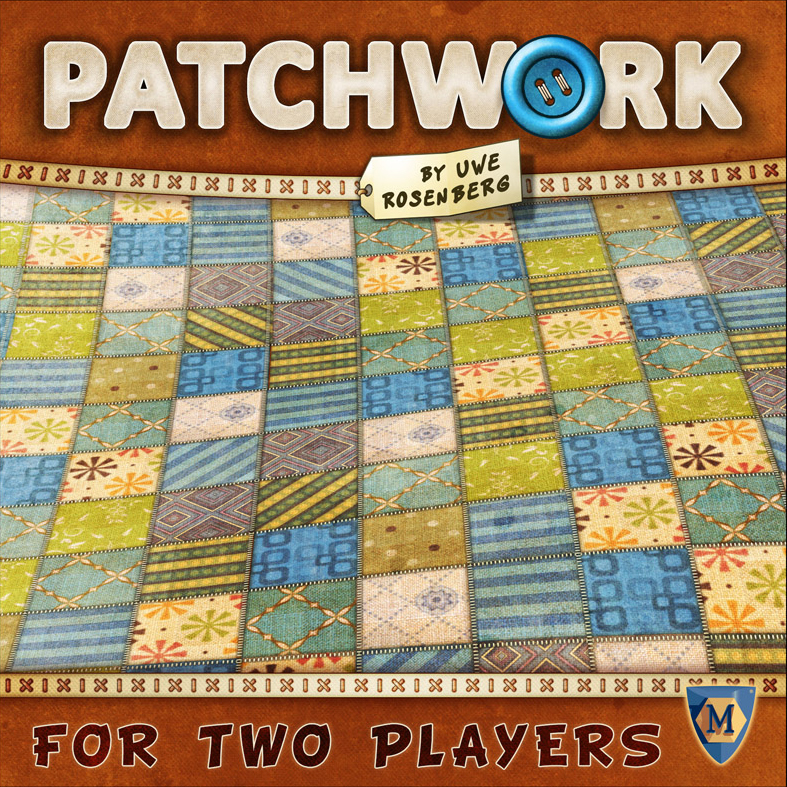Doug's Dungeon - Patchwork
Man, being ‘the board game guy’ among your friends can be tough, especially when you tend to host them for game nights a lot. Usually it can be great when you have just the right number of people. Around four to six is perfect, since most of the games I have are really able to shine with such player numbers. Sometimes you’ll have a massive group over, when only games like Concept and Werewolf can accommodate.
Other times, of course, you’ll have one friend over. Maybe Sophie’s gone out to see a friend for the night and you feel crippling loneliness so you invite a friend over. But what games can you bring out? Blood Rage is an all star for four players, but playing it two-player feels like gambling. Even Mysterium needs you to alter the rules drastically to let you play with so few people. Indeed, many board games you will find will try their best to widen their player-limit range to make them more appealing, only to come out with some inelegant ruleset for 2-3 players. If only… IF ONLY there were games that were suited to two *and exclusively two* players (that don’t have to resort to teaching your friend how to play one-on-one Commander because wow that’s cruel. Also those decks are tuned for 3+ players so the problem hasn’t gone away).
Don’t be coy, Doug. We wouldn’t be here if you didn’t have something ‘2 playery’ to show off.
Very well, italicised speaker. Allow me to introduce you to Patchwork:
As the box art takes a very large portion of it’s front cover to inform you, Patchwork is a tile placing game FOR TWO PLAYERS. The TWO PLAYERS will spend their turns earning buttons and spending them on tetris-like tiles that vary widely in shape in size. These tiles will be slotted together on the TWO PLAYERS’ boards until they run out of game time. Finally they (you know, the TWO PLAYERS) will be scored for their buttons, *minus* the gaps in their boards.
One of the key elements to know about this game is how turns function. The center of the play space is dominated by a spiralling track with a token for each of the TWO PLAYERS(ok I’ll stop) to keep track of how much time they have spent. When a player claims a patchwork tile on their turn, the tile has a time value that pushes your token forward. In time. On the time track. After playing out your turn, the next turn is taken by whomever is furthest behind on the track. By this moniker, a player can (and will) take several turns in a row! This forces players to think about how much time they are willing to give to the opponent. The more ahead you are, the more leeway your opponent has in their actions until they catch up. The time track also features 1x1 tiles to fill those impossible-to-fill gaps as you pass them, but you have to get to them first.
The time track also give players buttons at specific intervals. The number of buttons you receive is based on how many buttons are printed on the tiles you have purchased and placed on your board. Players need to keep in mind the power of ‘income generating’ tiles. Additionally, you have to check for whether or not purchasing said tiles will produce a return of investment (by checking the number of income spots remaining on the time track) by the end of the game. You can also simply spend you turn ‘earning buttons’. This will throw you just in front of your opponent in time, but you will earn a button for every space you travel doing so.
As for the tiles themselves, they begin the game arrayed in a big loop around the time track. Placed on the loop is the ‘neutral’ token. Players can only pick from the first three tiles clockwise from this token, and doing so moves the token to the picked tile’s position. This mechanic injects a really interesting planning aspect to the game. Players need to look at the state of the tile loop and see what moves they can afford to do, and what implications their turns will have for their opponent. This combined with the time mechanic makes Patchwork a real brain exercise every turn. To top it off, there’s even a bonus that can be earned by creating a complete 7 x 7 grid of tiles within your board.
Despite the intense depth, I found Patchwork to be a very approachable game. It’s extremely simple to pick up and play, and the cathartic feeling of slotting the unwieldy shapes into a big square is incredible. Whenever I see the question posed online “Hey what’s a good 2 player game?” The answer is generally
“We’ve already answered that question”. After that, the forums become helpful and will always have people point to Patchwork. Aaaaand 7 Wonders duels. But I’ll talk about THAT beast next week.
Don't own Patchwork yet? No problem, you can find it on our webstore here.

Doug Moore

I'm an avid lover of all things table top. I also have a growing collection of board games which inspire me to create my own. I put my loud and expressive personality to good use as a dungeon master for my friends, having run many campaigns through 4th and 5th edition D&D.
Follow him on Twitter
@Dugggernaut
















